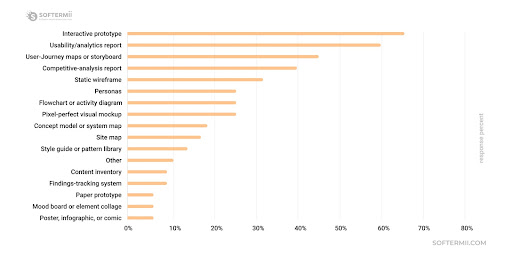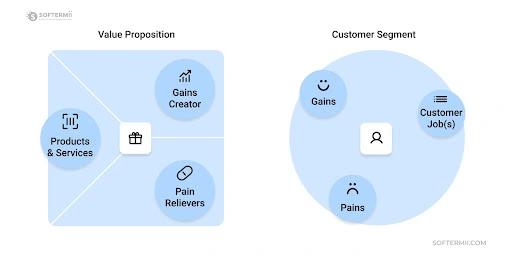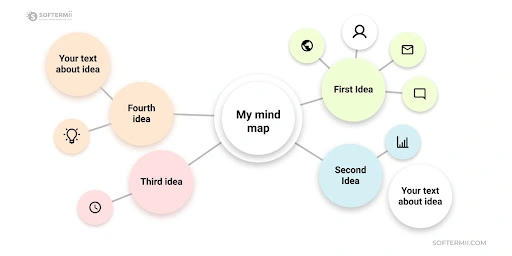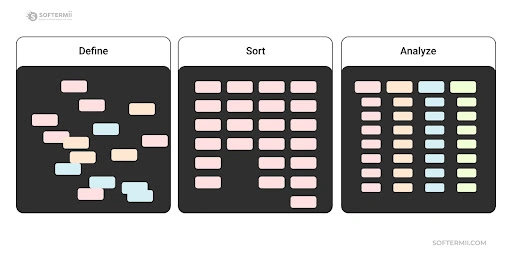Table of Contents
Looking for ways to improve your user experience (UX) design? Check out this comprehensive list of 20+ UX methods and deliverables to include in your next project.

Designing a UI/UX that accurately represents a product's ideas, generates conversions, and pleases users can be daunting for any business. A consistent UX design process must be established to develop an engaging and user-centered UI/UX that maximizes conversions, utilizing the most effective UX deliverables for workflows.
The foundation of any successful design is the concept of user experience (UX) design, which employs various techniques and methods to enhance the product or service's usability and user experience.
You could be mistaken if you believe your product is exceptional and doesn't require much attention to its UX. Nowadays, UX has become an essential and indispensable step in building and growing your business. Despite being practical and functional, a great product may not lead to massive success without an appealing user experience. Therefore, UX undoubtedly plays a critical role in influencing an enterprise's ability to achieve its objectives.
To learn more about the significance of UX research deliverables and the most frequently utilized ones in the design process, continue reading our post.
Using UX Methodologies and Deliverables: Why and How
You're not alone if you're wondering why and how to incorporate UX methodologies and deliverables into your UI/UX design process. You may question their usefulness and practicality.
However, utilizing these methodologies and deliverables can help you create an engaging and efficient user experience design that meets your product's objectives and values while catering to customers' needs.
By implementing UX deliverables effectively, you can design a product that showcases and promotes your brand and stands out with a unique design that attracts and retains clients, viewers, or customers.
To reap maximum benefits, using various UX methods and deliverables at specific stages of the design flow is crucial. For example, the web design process typically comprises the following phases: user and competitor research, defining product value and design strategy, building the information architecture of product design, wireframing and prototyping, testing, and evaluation.Each stage of the design process requires different UX deliverables and methodologies to be applied accordingly.
According to Nielsen Norman Group, UX deliverables refer to records of specific design work. They have also collected data on the most frequently used deliverables by the design development team:
The requirement for implementing user experience deliverables varies based on the project's specifications and intended audience. Additionally, different methods are necessary for each stage of UX activities. Nonetheless, the fundamental principle remains that deliverables document the critical steps in the design process.
Top 20+ UX Methodologies & Deliverables
Let's delve into the core aspects of any project's most common UX deliverables, considering the importance of building your design process correctly and utilizing deliverables.
Stakeholders Interview
This method is crucial when developing the product design from scratch and during the first and subsequent interviews. Stakeholders invest significant resources in the design project, including finance, time, and energy. Therefore, asking relevant questions is essential during these sessions to understand the project goals, product design parameters, user insights, and assumptions.
After conducting stakeholders' interviews, create a design roadmap, timeline, and task assignment. The primary goal of stakeholders' interviews is to develop the entire product design strategy and KPIs to track its performance during the UX design process.
User Research
User research is a fundamental step toward achieving success in the entire design process. Therefore, it's essential to conduct thorough and detailed research; otherwise, designing without in-depth user research could lead to the market failure of the product.
User research involves studying the target audience and creating buyer personas like product users. Defining critical design elements for them is also necessary. Techniques such as users' stories and use cases can be helpful in this regard.
User Interviews and Surveys
User interviews and surveys are essential in user research and design testing stages. They help UX designers gauge user satisfaction with their products.
Competitive Analysis
Competitive analysis is a crucial UX deliverable used in the research stage. Its purpose is to study and analyze competitors' products, identifying gaps in their design. By observing what works and what doesn't work for competitors, you can use that information to your advantage.
Product Value and UX Value Proposition
Defining the product's value proposition is the backbone of the design strategy and is typically done after a stakeholder interview. The product value proposition is the unique selling proposition, highlighting the core aspects that differentiate it from similar products on the market.
It includes what the product is, who it's for, the customer problems it solves, and its key benefits.
Moreover, applying the product value proposition in design development is important, known as the UX value proposition. The main idea of the product's values should be consistent, coherent, and visually reflected in its design.
It implies that your product design must emphasize its distinctive values. Therefore, your design team and marketing department must determine your product's values and the emotions its visual appearance must evoke before starting the design process. By incorporating this concept into the core, you can establish a UI/UX strategy that enhances the effectiveness of the product message you want to convey to customers.
Developing a Product Design Strategy and Roadmap
Creating a product roadmap is crucial as it outlines a plan for each step of the design process and identifies product-specific features. These techniques are essential as they guide designers throughout the product design life-cycle.
A product strategy allows UX designers to identify target audiences and focus on product ideas and consumer attributes. It may seem straightforward, but it is effective.
Creating Customer Journey Maps
Designers typically use this deliverable during user research, product strategy, roadmap development, and testing and evaluation stages. Customer journey maps illustrate how users will interact with the product, outlining their motivations and needs and adapting the product to them.
Deliverables for Information Architecture
Information architecture involves organizing and presenting data in an easily understood way. This process creates deliverables such as site maps, content organization, navigation, taxonomies, and decision tables. These deliverables provide precise design documentation and wireframes for digital products.
Prototyping and Mind Mapping
These UX deliverables are also relevant to information architecture. They are used during the wireframe and prototype stages. They aim to develop the product's informational structure, including workflows, navigation, and information architecture. Prototyping and mind mapping allow designers to visualize the final design before its development, generate new ideas, and reduce the number of post-deployment edits. Many tools are available for easier prototyping and site mapping, making these techniques worth using.
Brainstorming Technique
The brainstorming technique is a common project management deliverable that is useful throughout the design process, including UX. It is a tool to generate new ideas and solve problems.
Cultural Probes
Cultural probes are a technique used to gather inspirational data about people's lives, values, and thoughts and to find new design ideas. Cultural probes acknowledge that cultures influence design perception and provide insights into how to optimize UX design for people from different cultures if the product targets a worldwide audience.
Usability Testing
Usability testing can be used during the user research stage and is often implemented during the evaluation stage. This method identifies problems in product usability and helps improve it. It can be done through various testing methods such as focus groups, A/B testing, UX tree, guerilla testing, accessibility audit, and eye-tracking.
Guerrilla testing
Guerrilla testing is a straightforward methodology that can be carried out anywhere, anytime, for physical products. It involves a researcher approaching a relevant audience and asking about their experience with the product.
Card Sorting
Card sorting is a UX technique that can be used in the evaluation and testing phases of information architecture development. This method involves a group of users who arrange cards containing parts of information structure elements to reflect their understanding of the product's full information structure. Designers often use this exercise to develop information architecture.
A competitive audit
A competitive audit is a detailed analysis of similar products' features that have given them an edge in the market. As the name suggests, you are observing your competitors to learn what strategies work for them, so you can implement them and stay competitive.
A/B testing
A/B testing is a helpful technique in UX design. It involves providing your product and a supplementary product to different users and recording their reactions to determine which one performs better. The goal is to identify areas of your product that need improvement.
Focus Groups
Moderated discussion with about 5 to 10 participants; focus groups are a subtle user experience strategy. You can bring people together to discuss issues and concerns about the user interface's features. Usually lasting about 2 hours, a moderator leads the group's discussion to maintain focus.
Heuristic Evaluation
Heuristic evaluation is a usability inspection technique used in the testing and design evaluation stage. Nielsen and Molich's 10 User Interface Design Heuristics provide guidelines for design development. This technique focuses on specific UI design elements, evaluating their good and bad sides that impact user interactions.
Typically, heuristic evaluation involves evaluating between five and ten items of the product, website, or application design and should be provided by experts in the business industry, not end-users. Conducting a heuristic evaluation will yield valuable results.
Usability Test Report
Usability testing determines the degree of ease users encounter when using the product. The usability test report summarizes the findings clearly, concisely, and descriptively. The test should involve real users. Project teams use the report to identify issues in the proposed or functional design and find a suitable solution.
According to Nielsen Norman Group, the definition of UX deliverables is a documentation of the design work.
Analytics Audit
Analytics Audit is a type of UX deliverable that involves identifying problematic areas of a website or app that affect user experience, reducing conversion rates, and optimizing them.
Content Strategy
Content Strategy is another UX deliverable that focuses on planning the publication of digital content to promote the product. Although designers may not be directly involved, they should be familiar with it to ensure that the UI/UX matches the communication style.
Sitemaps
Sitemaps are important UX deliverables that come after wireframes during the design strategy stage. They represent the overall structure of the product with hierarchically arranged elements.
The Significance of UX Techniques and Deliverables in the Design Process
The success of the design process relies heavily on UX deliverables, which serve as the foundation for achieving the best user experience. The "design" aspect of UX aims to enhance a user's interaction with a product or service in terms of usability, efficiency, and effectiveness. As such, UX deliverables and techniques are crucial for the following reasons:
- They ensure a consistent and clear design process, improve teamwork, and promote ongoing design evaluation at every development stage.
- They provide the necessary data elements for constructing a highly efficient and usable design.
- They serve as the drawing board for continuous improvement and refinement of designs.
- They are instrumental in collecting input and output to produce UX designs.
The choice of UX deliverable depends on the design process and can vary across different teams. Creating a user experience that meets the customers' needs and satisfies them is not the sole responsibility of one person or team but a company vision. Therefore, clean, simple, intuitive, flexible, and engaging designs can be created collaboratively, distinguishing the product or service from competitors.
Avoid These Mistakes in Your UX Design Process
To achieve the best user experience, you must be mindful of some limitations and challenges that may arise during the UX design process. Here are some mistakes you should avoid:
- Focusing solely on the aesthetics of the product and neglecting its functionality.
- Ignoring the feedback and needs of your users.
- Overlooking unforeseen circumstances and only considering ideal scenarios.
- Overloading your product with too much information, disregarding UX deliverables like heatmaps and content strategy.
- Neglecting responsive design.
You can easily avoid these pitfalls by incorporating UX deliverables and methods into your design process.
Final Thoughts
The UX deliverables and techniques discussed are essential to the entire UX design process. Their use directly affects sales and customer satisfaction. If you need an exceptional UX design to boost your growth, outsourcing your project to reliable and experienced vendors may be the best and most cost-effective solution.













